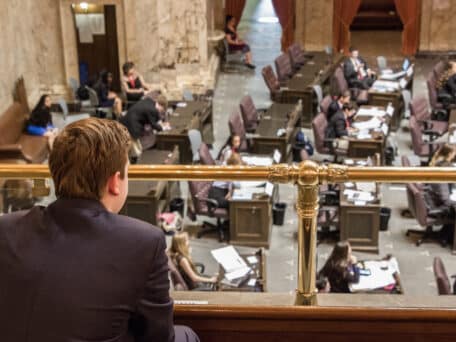It’s April Fool’s Day and, in light of the occasion, Shift came up with a little quiz we’re calling “April Fool’s or House Democrats’ budget.” So, go ahead a test how much you may or may not know about Democrats’ 2015-17 budget plan and look for the answer key below.
- Democrats’ budget raises taxes on working Washington families in order to fund nearly $1 billion worth in pay raises for state employees.
- Democrats’ budget would fully fund the Washington Education Association’s (WEA) Initiative 1351, the union’s latest money-grab that it managed to squeak by voters by claiming it was about “reducing class sizes”.
- Democrats’ budget includes Jay Inslee’s cap-and-tax scheme.
- Democrats’ budget would implement a state income tax by creating a state capital gains income tax.
- Democrats’ budget reverses the party’s 30-year long trend and actually prioritizes education funding.
Answer key:
- House Democrats’ budget.
Democrats’ $39 billion budget plan would implement a whopping $1.5 billion in new taxes for the 2015-17 cycle. The tax hikes would increase to $2.4 billion during the next budget cycle. Democrats need the historic tax increases in order to reward their million-dollar campaign donors—the Washington Education Association, the Washington Federation of State Employees and the Service Employees International Union (SEIU)—with $867 million in pay raises, a result of Jay Inslee’s secret negotiations with the top union executives who supported his campaign.
By contrast, state Senate Republican’s 2015-17 budget plan meets the state’s funding obligations—prioritizing education spending at a 3-to-1 ratio versus general government spending—without raising taxes. Under the GOP plan, every state employee would receive a flat $2,000 raise over the next two years. Top budget writer Sen. Andy Hill pointed out that the new approach would give a larger percentage raise to lower-paid workers and the state would save taxpayers about $75 million in the state’s 2015-17 budget.
- April Fool’s!
Not even House Democrats would cater to the absurd demands of the WEA’s I-1351. Democrats’ budget alters I-1351, funding reduced class sizes for K-3 grades, not K-12. The change is in-line with research that shows reducing class sizes to the extent demanded by I-1351 has no impact after the 3rd grade – though it would create more dues-paying WEA members, which is the union’s primary goal.
The Senate Republican’s plan would do the same, with a key difference. Democrats’ proposal leaves the door open for the WEA to achieve its goal to create more dues-paying members in the future. Unlike the Democrats’ plan, Republicans actually deal with I-1351 once-and-for-all by sending the change back to voters for a referendum vote.
- April Fool’s!
Again, not even House Democrats would implement Jay Inslee’s job-destroying cap-and-tax scheme. In fact, the lack of Inslee’s beloved cap-and-tax scheme is the only real element of House Democrats’ budget that provoked complaint from liberals.
Shift was the lone media voice pointing out that it was House Democrats, not legislative Republicans, who could not provide enough support to pass Inslee’s gas-price raising scheme in the weeks leading up to the budget introduction.
Why Democrats chose to not proceed with the cap-and-tax scheme isn’t too difficult to understand—one study found it would reduce 56,000 jobs over the next 20 years. The scheme received the disapproval of media outlets across the state—the Tri-City Herald said, at best, the scheme was a “stopgap.” And, as Shift pointed out, Inslee’s entire cap-and-tax scheme relied on gross distortion of facts. Top House Democrats’ attempts to defend the policy quickly unraveled—budget writer Ross Hunter actually argued in favor of the cap-and-tax scheme using a study that contradicted his assertions.
- House Democrats’ budget.
Democrats’ $39 billion budget plan would create a state capital gains income tax—along with a hike in the state B&O tax—at a 5% rate on individuals, with certain exemptions. The plan contrasts slightly with Jay Inslee’s proposed tax rate of 7%.
Democrats and their far-left supporters have trumpeted the state capital gains income tax as a means to make Washington State’s tax system “fair.” But, that’s far from the case. The capital gains income tax is a notoriously volatile form of taxation, hardly reliable as stable revenue source. Considering the disproportionate impact the tax has in the long term, it certainly is not fair form of taxation.
Democrats are attempting to bypass the state constitution by classifying the state capital gains income tax as an “excise tax.” Of course, a capital gains income tax is not an excise tax. It is a tax on income. As such, the state capital gains income tax is not only an unreliable source of revenue, its likely unconstitutional.
- April Fool’s!
As pointed out above, Democrats proposed historic tax hikes including a state capital gains income tax. Democrats’ far-left supporters applauded them for making the state capital gains income tax the “centerpiece” of their budget plan. You can find out why that’s nothing to be proud of here (hint: it has to do with the tax’s notorious volatility).
Democrats justify a state capital gains income tax by falsely claiming the new tax is needed to meet the state Supreme Court’s McCleary decision to fully fund our public schools. It’s Democrats way of proving they have changed their attitude and have finally decided to prioritize education funding. However, by proposing the tax, Democrats proved the opposite.
It’s not only false that new taxes are needed to meet the McCleary decision (as Republicans proved in their budget plan), but Democrats are also proposing to fund our state’s first constitutional requirement via a volatile, unreliable state capital gains tax. That proves that Democrats have reverted back to their old ways and are refusing to prioritize education. Once again, they have placed special interests before education funding.
By contrast, Republicans’ budget delivers a 25 percent cut in college tuition and reverses a 30-year trend by prioritizing new education dollars at a 3-to-1 ratio versus general government spending. It truly puts education first.




